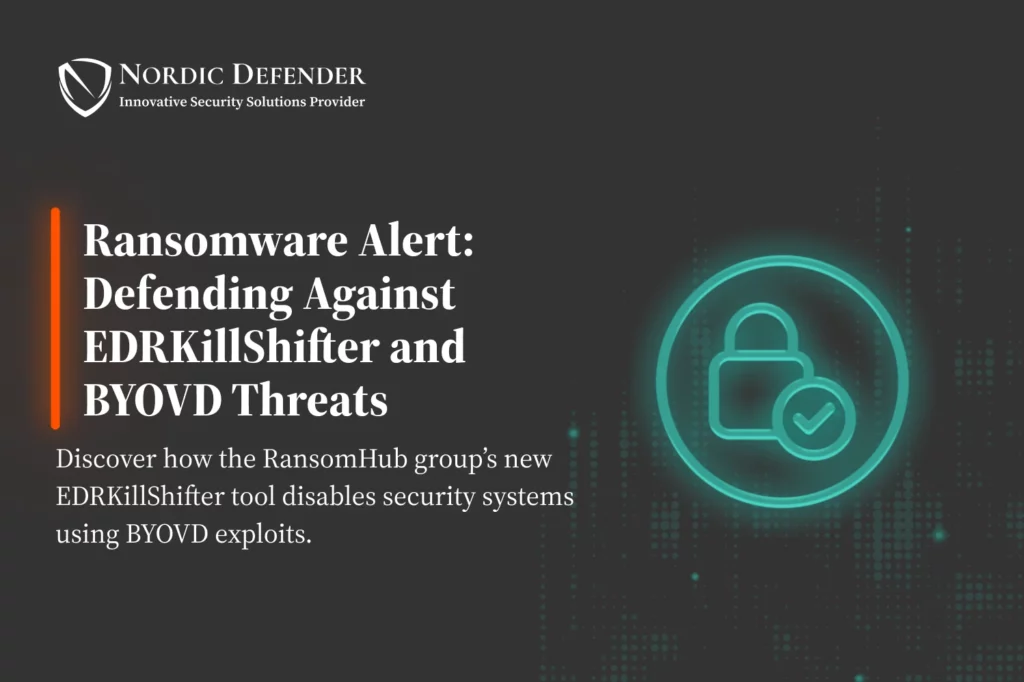In the ever-evolving landscape of cyber threats, ransomware groups are consistently finding new ways to bypass even the most robust security measures. Recently, the RansomHub group, known for deploying ransomware at scale, introduced a powerful technique for neutralizing endpoint defenses, highlighting a concerning trend for organizations worldwide.
The group’s newly adopted tool, “EDRKillShifter,” effectively disables Endpoint Detection and Response (EDR) systems by exploiting vulnerabilities in legitimate drivers. This approach—part of a growing attack method known as “Bring Your Own Vulnerable Driver” (BYOVD)—allows cybercriminals to sidestep the sophisticated detection mechanisms meant to identify and halt suspicious behavior. Once EDR systems are offline, attackers can deploy ransomware and other malware without facing immediate resistance.
A Closer Look at BYOVD Exploits
BYOVD is not a new concept, but its adoption by high-profile groups like RansomHub signals an increasing willingness among cybercriminals to exploit older, trusted technology. The core idea is simple: by introducing a legitimate, yet vulnerable, driver into a system, attackers can bypass normal security scrutiny. Since EDR and antivirus solutions typically trust legitimate drivers, the attackers can operate undetected, opening a wide door for further malicious activity.
The spread of such tools, now easily available for purchase on dark web marketplaces, indicates that ransomware groups are becoming increasingly professional in their approach, mimicking traditional businesses with toolkits, customer support, and detailed attack blueprints.
The Rise of Toolkits on the Dark Web
The availability of EDRKillShifter and similar tools on dark web forums is a troubling development. These tools are no longer limited to elite cybercriminals with advanced skills. Instead, they can be purchased and deployed by less-experienced actors, leading to a broader swath of organizations being targeted by ransomware. The democratization of these attack vectors means the barrier to entry for launching sophisticated attacks has been lowered dramatically.
This increased accessibility is especially dangerous for industries that lack the resources for advanced cybersecurity defenses. It also shifts the nature of ransomware attacks from being merely a financial threat to posing serious operational and reputational risks. With EDR systems down, organizations face not only potential data loss but also the shutdown of essential services, creating a domino effect that can lead to long-term damage.
What Can Organizations Do to Defend Against EDRKillShifter?
As ransomware tactics become more sophisticated, cybersecurity defenses need to evolve in parallel. Here’s how organizations can protect themselves:
- Rigorous Driver Management: Organizations must adopt stricter control over which drivers are allowed on their systems. This includes real-time monitoring and the removal of outdated or vulnerable drivers that may become targets for BYOVD attacks.
- Advanced Patching and Vulnerability Management: While basic patching is a common practice, many organizations lag in updating older hardware drivers. Regular audits of all systems—including drivers—should be conducted, with an emphasis on removing or updating any components susceptible to exploitation.
- Zero Trust Architecture: The principle of “never trust, always verify” should be implemented across the organization’s network. Zero trust architecture minimizes the potential damage that attackers can cause by limiting access to sensitive systems and data, even if they manage to disable endpoint protections.
- Multi-Layered Security Solutions: While EDR systems are critical, relying solely on them leaves organizations exposed when those systems are disabled. A layered security approach, incorporating firewalls, intrusion detection systems (IDS), and behavioral monitoring, ensures that other defenses remain intact even if EDR fails.
- Incident Response and Backup Strategies: A well-prepared incident response plan is critical. Organizations should practice drills that simulate EDR failures, ensuring that teams know how to react quickly. Additionally, backups should be isolated from the network and regularly updated, so systems can be restored without paying ransom.
Looking Forward: The Future of Ransomware Defense
The rise of BYOVD and EDR-disabling tools like EDRKillShifter should act as a wake-up call for businesses. Traditional cybersecurity strategies are no longer enough in an era where ransomware attackers can neutralize core defenses before launching their attacks. Moving forward, businesses need to invest in both technology and cybersecurity awareness.
While tools and technology are important, it’s equally vital to build a culture of security within organizations. Employees should be trained on best practices for cybersecurity hygiene, such as recognizing phishing attempts and the importance of reporting suspicious activity.
By anticipating the next wave of ransomware attacks and evolving their defenses, businesses can stay ahead of cybercriminals and protect their critical assets from the growing threat landscape.
Conclusion
As ransomware groups become more sophisticated, the need for advanced, multi-layered security becomes more urgent. Tools like EDRKillShifter represent the new face of ransomware attacks, where simply having endpoint protection is no longer sufficient. Organizations must adopt proactive measures, including real-time monitoring, vulnerability management, and zero trust architecture, to defend against these growing threats.
By staying informed and vigilant, businesses can significantly reduce their risk exposure and build a more resilient defense strategy against ransomware. If your organization needs assistance in developing or refining its cybersecurity approach, our team of experts is ready to help. Reach out to us today for a comprehensive security consultation.
